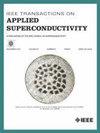Test Results and Analysis of the MQYYM Magnet at 1.9 K in STAARQ, a New CEA Paris-Saclay Test Facility
IF 1.7
3区 物理与天体物理
Q3 ENGINEERING, ELECTRICAL & ELECTRONIC
引用次数: 0
Abstract
In the initial framework of HL-LHC project, a 90 mm Nb-Ti single aperture quadrupole short model with a gradient of 120 T/m at 1.9 K, has been designed, manufactured and firstly tested at 4.2 K as part of a collaboration between CERN and CEA. This magnet called MQYYM has been recently tested for the first time at 1.9 K and used as a reference magnet for the commissioning of the new CEA Paris-Saclay cryogenic test facility STAARQ (standing for test station for quadrupole accelerator magnets). This test station has been developed to test superconducting magnets up to 5 m-long at 1.9 K in a 1 bara helium bath with a lambda plate. Magnets can be powered up to 13 kA thanks to hybrid HTS current leads. It relies on digital and analog MSS (Magnet Safety System) for quench detection as well as on several types of instrumentation, from voltage taps and temperature sensors to strain gauges. This paper describes and analyzes the test results of MQYYM at 4.6 K and 1.9 K as part of the facility commissioning, with a special focus on mechanical measurements and protection results. In particular, it will conclude on the protection heater validation, necessary for the upcoming MQYY tests.求助全文
约1分钟内获得全文
求助全文
来源期刊

IEEE Transactions on Applied Superconductivity
工程技术-工程:电子与电气
CiteScore
3.50
自引率
33.30%
发文量
650
审稿时长
2.3 months
期刊介绍:
IEEE Transactions on Applied Superconductivity (TAS) contains articles on the applications of superconductivity and other relevant technology. Electronic applications include analog and digital circuits employing thin films and active devices such as Josephson junctions. Large scale applications include magnets for power applications such as motors and generators, for magnetic resonance, for accelerators, and cable applications such as power transmission.
 求助内容:
求助内容: 应助结果提醒方式:
应助结果提醒方式:


